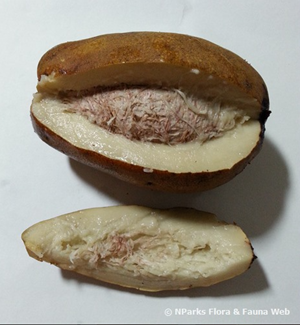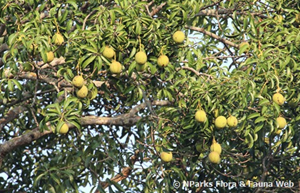Ubin Fruit Orchard
Situated along Jalan Ubin, the fruit tree arboretum on Pulau Ubin will be the first of its kind in Singapore. Named ‘Ubin Fruit Orchard’, the site was previously a fruit orchard belonging to a resident on the island. About one hectare in size, the arboretum will feature a collection of some 350 fruit trees that were once commonly planted in kampungs. Visitors can expect to see over 30 species of trees including rambutan and starfruit. The arboretum will also showcase uncommon cultivars of durian and mango. Students from Nanyang Girls’ High prepared interpretive signs and students from Ngee Ann Polytechnic assisted with planting works for the arboretum.
The Ubin Fruit Orchard is one of the highlights in NParks’ new Rustic Reflections Tour, on every third Saturday of the month.
 |
Common Name: Soursop Annona muricata is a low-branching and slender plant. Normally evergreen, its leaves are smooth and glossy, but tend to have an offensive smell. Fruits will appear after 3 to 5 years, and are best harvested when the fruit is fully-grown and firm. The fruits are considered mature when their spines are far apart and their shiny green colour becomes dull green or yellowish-green. Fruits are best eaten 5 to 6 days after harvesting and are used in desserts and drinks. |
 |
Common Name: Breadfruit Artocarpus altilis is an evergreen tree in humid tropics but semi-deciduous in Page 2 of 4 monsoon climates. Its fruits and seeds are boiled, baked, roasted or fried before consumption. By letting them ferment, the fruits can be made into a nutritious cheese-like paste for baking into cakes. |
 |
Common Name: Binjai
The Mangifera caesia is a large tree that can grow up to 45m tall. The young leaves are used to prepare lalab (a leafy vegetable dish). Its fresh fruits can be eaten, and are used to make home-made creamy juices. The fruits can also be used as a tamarind substitute. They are also utilised as ingredients in the preparation of ‘sambal’ (a type of chilli-spice mixture), or rojak (a fruit-and-vegetable salad dish). |
 |
Common Name: Bachang The egg-shaped fruit is yellowish or greyish-green. When ripe, the fruit is strongly scented. The single seed is enclosed in a woody capsule in the centre of the fruit flesh. Its fruits are used in curries, pickles, rojak, and to make chutneys or sweetmeats. The bark can be made into a lotion for treating ulcers, and its leaves can alleviate or prevent fever. Its seeds are used for conditions such as eczema and scabies. |
 |
Common Name: Chiku Its young fruits can be boiled and the decoction drunk to treat diarrhoea. A paste made from the seeds can be applied to bite and sting wounds. In Indonesia, the young leaf shoots are washed and eaten raw or together with rice. Its wood is strong and durable, and used to make beams and furniture. |
 |
Common Name: Jambu air Scientific Name: Syzygium aqueum The fruits are eaten fresh or preserved. It has a sweet, but slightly astringent taste. Sometimes, they are boiled briefly and sweetened with a little sugar. They are also added to soups and rojak. The fruit skin is rich in Vitamin A. |

